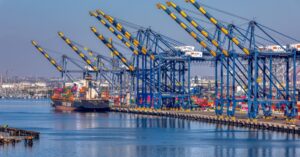With the settlement of a labor agreement between port owners and dockworkers along the East and Gulf coasts, one worrisome freight industry disruptor, at least, has been taken off the table. But lingering concerns over the potential for trade wars, the economy and geopolitics, and freight rates and capacity are front and center with shippers as they execute (and adjust) their 2025 transportation plans.
We’ll take a look at each of these issues and how they’re expected to impact the freight industry this year.
Coming Tariffs and Threats of Trade Wars
With incoming President Donald J. Trump promising tariffs as a stick to enforce stricter border security at home, and to protect American manufacturing more broadly, all eyes are on his first 100 days in office. Many economists fear inflation blowback just when it’s cooled, expecting retailers and manufacturers to bake in the excess costs.
Trump has proposed a 25% tariff on goods from Mexico and Canada, both key trade partners, and talks are progressing alongside heated rhetoric from both countries. The Mexico tariffs have a definite connection to China policy. Many Chinese companies import raw goods south of the border, assemble them there, and slap on “made in Mexico” labels to circumvent stiffer tariffs. And Canada’s response bears watching with Prime Minister Justin Trudeau’s imminent departure as the backdrop.
With both countries, Trump is also looking via stricter trade policy to force the U.S. neighbors to act more aggressively against illegal immigration and the importation of deadly fentanyl, two promises that helped him win a landslide victory.
Per Axios, Trump is considering either an aggressive, disruptive tariff approach using broad emergency powers or a more measured plan in line with actions in his first term, much of which President Biden kept in place. While it’s unclear which way the incoming administration is leaning, and how much is calculated “Art of the Deal” bluster, the “big stick” option is sure to trigger more aggressive retaliatory measures from trading partners.
So far, the tariff war of words led to massive freight frontloading on the part of importers in recent months, as companies stocked up before rates rise. Then the bottom fell out again. Per the Cass Freight Index, shipments fell 7.3% sequentially in December and were down 6.5% year over year.
ACT Research is calling for modest freight growth of 1.8% in 2025, due to retail inventory levels stabilizing and slower replenishment cycles across most sectors. Overcapacity is expected to be an issue through most of 2025 as rebalancing continues.
The Future of EVs and Sustainability
Politics does indeed make strange bedfellows, as the tight bond between Trump and Elon Musk illustrates. On its face it’s an unlikely relationship, given the incoming president’s well-known stance against the growth of sustainability objectives and in particular EV mandates.
Trump will certainly find ready allies among trucking interests, as the industry has pushed back hard against Biden-era EV objectives as economically, well, unsustainable. Automakers have also found consumer interest not as strong as they had hoped. But what of Musk, an EV entrepreneur, having Trump’s ear in this important moment? It’s possible his position could moderate under that influence.
When it comes to net zero goals, with many companies having targeted 2040, a Trump EPA – whether run by former New York GOP Rep. Lee Zeldin or someone else – would certainly push to roll back those plans. The movement is clearly in the other direction when it comes to climate goals with Trump back in office. A key indicator: massive fund manager BlackRock pulling out of the UN’s Net Zero Alliance.
A general pullback from net zero goals is certainly a plus for the transportation sector, given the massive costs and investment involved. Still, many transportation industry players see value in contributing to long-term sustainability goals if the approach is practical, economically viable, and supported by innovation.
Mixed Bag in Freight Demand, Rates Across Modes
Global air freight demand is projected to grow 4% to 6% in 2025, according to Xeneta, with capacity increasing 3% to 4%, which spells an uptick in rates. This will be driven by robust e-commerce growth grabbing capacity, mainly out of China (up 14%), and continued disruption in ocean container shipping, even with the Red Sea situation plateauing.
Speaking of ocean, CEVA Logistics is calling for ocean container demand growth of 3%, at the low end of Drury’s 3%-4% projection, due to low consumer confidence and the impact of tariffs. (Note: This projection came before the ILA-USMX settlement.)
An oversupply of capacity from new vessels coming online is expected to be a drag on rates. This will be the case even though fleet growth will slow from 10.5% in 2024 to 3% in 2025, and Cape of Good Hope diversions won’t absorb all the excess capacity, per Maritime Strategies International analyst Daniel Richards.
According to Drewry, global container shipping rates are forecast to increase 4%, with elevated spot rates feeding into the contract market. Despite new vessel capacity, ocean contract rates on routes to the U.S. are likely to rise, while spot rates on east-west routes could decline in the second half of 2025.
Industry sentiment in trucking, it seems, depends on who you ask. Software giant Trimble’s annual survey of 100 U.S. and European supply chain leaders found 75% of carriers and 3PLs had “strong optimism” for 2025, while just 38% of shippers are looking at the year positively.
DAT group project manager Chad Kennedy said in a December podcast he’s expecting a 1% to 2% increase in contract rates for trucking in the first half of 2025, based on feedback from shippers, increasing to 3%-4% on the back half. The falloff from tariff-induced frontloading is expected to soften spot market demand and rates in Q1, per DAT. And the resulting exodus of spot market carriers on the bubble may lead to a subsequent correction in rates, DAT analyst Dean Croke said.
The Dust Settling on Tariffs Will Tell Us a Lot About 2025
Much of what freight will look like in 2025 hinges on the impact of tariffs. What actually comes to pass in that regard will likely be south of the figures Trump has thrown out, but import volumes will be negatively impacted nonetheless. An easing of EV targets and sustainability mandates seems likely, a cost benefit to carriers and logistics providers. Rates and capacity will vary across air, ocean and trucking, with air seeing the most positive outlook for carriers based on a supply/demand imbalance.
In this type of volatile logistics environment, an experienced freight broker is an invaluable partner, helping shippers navigate the complexities and freeing them up to focus on growing their business.
With more than a quarter century of experience, COGISTICS Transportation offers 3PL solutions that combine agility, efficiency, regulatory expertise, and cutting-edge technology. Our advanced tools provide peace of mind on every shipment with order-to-door tracking. It’s all built to provide you with a tailored, streamlined experience across land, air, and ocean freight operations, whether domestic or international. When time is of the essence, COGISTICS offers reliable, cost-effective expedited freight solutions. Contact us today to get started.




